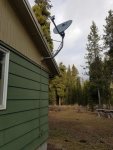Hello, I'm looking for a little help with wiring up an outdoor antenna. From browsing the forum it looks like some folks on here are super coaxial savvy. I'm incredibly new when it comes to this type of wiring and quickly get lost in the different types of coax cable.
What I'm looking to do is connect my RTL-SDR V3 to an outdoor antenna. I'm looking at either a Tram 1410 or Taurus D1000 antenna (might ask about this in the antenna forum later)
After having a look about the house, it looks like the easiest method of setting this up would be to use the existing unused DirectTV/Dish cables. There's already an interior wall port (see photo). It runs outside using what looks to be "RG-6 75ohm" coaxial. It then connects to some sort of wiring manifold (see photo) before it heads up to the dish. From the the dish mount I thought I would run a small extension pole/mast and attach my antenna.
So this leaves me with a couple questions.
1. Can I actually use the existing Direct TV/Dish cables?
2. What adapter do I need to connect from the RTL-SDR (which says it has an SMA F connector, currently connected to a 3 meter section of RG173) to the interior wall port?
3. What would I need to adapt from the RG-6 DirectTV/Dish coax cable to the SO-239 connection on the Antenna?
4. And lastly, which cable from the left side of that manifold would I connect to my antenna? In the photo, the cable connecting to the right side of the manifold heads into the house. I don't know if it matters which of the 4 cables on the left I connect to? Assuming they're all joined through the manifold. There's also a grounding wire coming out of the 4 wire bundle that maybe I should connect to the new antenna?
Holy smokes, this turned into a super long post, if you made it this far thanks for the read and I appreciate any help you can provide. Thank you!




What I'm looking to do is connect my RTL-SDR V3 to an outdoor antenna. I'm looking at either a Tram 1410 or Taurus D1000 antenna (might ask about this in the antenna forum later)
After having a look about the house, it looks like the easiest method of setting this up would be to use the existing unused DirectTV/Dish cables. There's already an interior wall port (see photo). It runs outside using what looks to be "RG-6 75ohm" coaxial. It then connects to some sort of wiring manifold (see photo) before it heads up to the dish. From the the dish mount I thought I would run a small extension pole/mast and attach my antenna.
So this leaves me with a couple questions.
1. Can I actually use the existing Direct TV/Dish cables?
2. What adapter do I need to connect from the RTL-SDR (which says it has an SMA F connector, currently connected to a 3 meter section of RG173) to the interior wall port?
3. What would I need to adapt from the RG-6 DirectTV/Dish coax cable to the SO-239 connection on the Antenna?
4. And lastly, which cable from the left side of that manifold would I connect to my antenna? In the photo, the cable connecting to the right side of the manifold heads into the house. I don't know if it matters which of the 4 cables on the left I connect to? Assuming they're all joined through the manifold. There's also a grounding wire coming out of the 4 wire bundle that maybe I should connect to the new antenna?
Holy smokes, this turned into a super long post, if you made it this far thanks for the read and I appreciate any help you can provide. Thank you!







